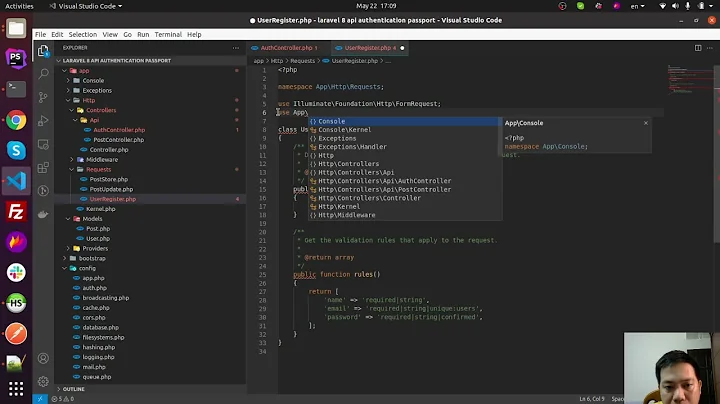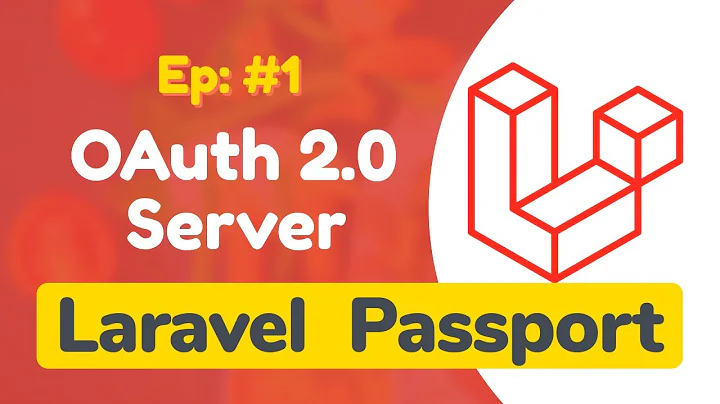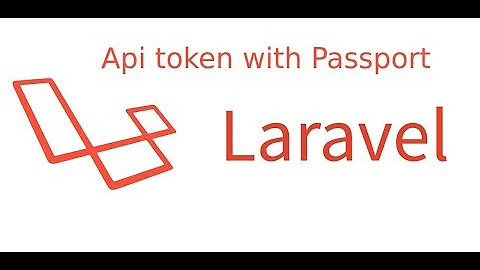Customising token response Laravel Passport
Solution 1
The instructions on how to do this are hinted in the BearerTokenResponse class (part of the league/oauth2-server package).
Tested on Laravel 5.7.
1. Extend the BearerTokenResponse class, add the extra params you need in the response.
namespace App\Auth;
use League\OAuth2\Server\Entities\AccessTokenEntityInterface;
class BearerTokenResponse extends \League\OAuth2\Server\ResponseTypes\BearerTokenResponse
{
/**
* Add custom fields to your Bearer Token response here, then override
* AuthorizationServer::getResponseType() to pull in your version of
* this class rather than the default.
*
* @param AccessTokenEntityInterface $accessToken
*
* @return array
*/
protected function getExtraParams(AccessTokenEntityInterface $accessToken): array
{
return [
'user_id' => $this->accessToken->getUserIdentifier(),
];
}
}
2. Create your own PassportServiceProvider class and override the makeAuthorizationServer() method in order to pass in your own BearerTokenResponse class.
namespace App\Providers;
use App\Auth\BearerTokenResponse;
use Laravel\Passport\Bridge;
use League\OAuth2\Server\AuthorizationServer;
class PassportServiceProvider extends \Laravel\Passport\PassportServiceProvider
{
/**
* Make the authorization service instance.
*
* @return \League\OAuth2\Server\AuthorizationServer
*/
public function makeAuthorizationServer()
{
return new AuthorizationServer(
$this->app->make(Bridge\ClientRepository::class),
$this->app->make(Bridge\AccessTokenRepository::class),
$this->app->make(Bridge\ScopeRepository::class),
$this->makeCryptKey('private'),
app('encrypter')->getKey(),
new BearerTokenResponse() // <-- The class you created above
);
}
}
3. Add your provider to the providers array in config/app.php
/*
* Application Service Providers...
*/
App\Providers\PassportServiceProvider::class,
4. Exclude the passport package from laravel auto-discovery in composer.json
This stops the default PassportServiceProvider class from being loaded.
"extra": {
"laravel": {
"dont-discover": [
"laravel/passport"
]
}
},
Then run composer install.
Solution 2
Two steps.
1. Add a new route in your routes file.
// routes/api.php
Route::post('oauth/token', 'AuthController@auth');
Keep in mind this will change the route for getting the token from /oauth/token to /api/oauth/token.
2. Add the controller method.
<?php
// app/Http/Controllers/AuthController.php
namespace App\Http\Controllers;
use App\User;
use Psr\Http\Message\ServerRequestInterface;
use \Laravel\Passport\Http\Controllers\AccessTokenController;
class AuthController extends AccessTokenController
{
public function auth(ServerRequestInterface $request)
{
$tokenResponse = parent::issueToken($request);
$token = $tokenResponse->getContent();
// $tokenInfo will contain the usual Laravel Passort token response.
$tokenInfo = json_decode($token, true);
// Then we just add the user to the response before returning it.
$username = $request->getParsedBody()['username'];
$user = User::whereEmail($username)->first();
$tokenInfo = collect($tokenInfo);
$tokenInfo->put('user', $user);
return $tokenInfo;
}
}
Solution 3
Im using Multi-Auth with passport, so the previous answers didn't help me.
After hours of "googling" I found this answer (after-) middleware.
My middleware basically gets the result of Passport auth, checks if there is an Bearer inside and append more data to the content.
<?php
namespace App\Http\Middleware;
use Closure;
class AppendTokenResponse
{
/**
* Handle an incoming request.
*
* @param \Illuminate\Http\Request $request
* @param \Closure $next
* @return mixed
*/
public function handle($request, Closure $next)
{
$response = $next($request);
$content = json_decode($response->content(), true);
if (!empty($content['access_token'])) {
$content['moredata'] = 'some data';
$response->setContent($content);
}
return $response;
}
}
Now put the new Middleware in $routemiddleware at App/Http/Kernel.php
/**
* The application's route middleware.
*
* These middleware may be assigned to groups or used individually.
*
* @var array
*/
protected $routeMiddleware = [
'auth' => \App\Http\Middleware\Authenticate::class,
'cors' => \App\Http\Middleware\Cors::class,
'multiauth' => \SMartins\PassportMultiauth\Http\Middleware\MultiAuthenticate::class,
'auth.basic' => \Illuminate\Auth\Middleware\AuthenticateWithBasicAuth::class,
'bindings' => \Illuminate\Routing\Middleware\SubstituteBindings::class,
'cache.headers' => \Illuminate\Http\Middleware\SetCacheHeaders::class,
'can' => \Illuminate\Auth\Middleware\Authorize::class,
'guest' => \App\Http\Middleware\RedirectIfAuthenticated::class,
'signed' => \Illuminate\Routing\Middleware\ValidateSignature::class,
'throttle' => \Illuminate\Routing\Middleware\ThrottleRequests::class,
'verified' => \Illuminate\Auth\Middleware\EnsureEmailIsVerified::class,
'oauth.providers' => \SMartins\PassportMultiauth\Http\Middleware\AddCustomProvider::class,
'append_auth' =>\App\Http\Middleware\AppendTokenResponse::class,
];
Then just register this middleware to Passport Routes in Providers/AuthServiceProvider.php
With Multiauth:
Route::group(['middleware' => ['oauth.providers','append_auth']], function () {
Passport::routes(function ($router) {
return $router->forAccessTokens();
});
});
I believe regular passport should be (not tested):
Route::group(['middleware' => ['append_auth']], function () {
Passport::routes();
});
Solution 4
Another better answer from the web
Custom Laravel Passport BearerTokenResponse
https://gist.github.com/messi89/489473c053e3ea8d9e034b0032effb1d
Solution 5
To add custom claims to your Passport token, here is a gist using Passport 8 with Laravel 6
https://gist.github.com/onamfc/0422da15743918e653888441ba6226ca
Related videos on Youtube
Irvin Chan
I am passionate about new technologies and software development. I enjoy searching for new and amazing technologies to learn. I always apply my knowledge and skills to overcome most of the problems with a bright solution. I consider myself as an entrepreneur, disciplined, and responsable person. Swift Flutter Python Ruby on Rails JS
Updated on June 04, 2022Comments
-
 Irvin Chan almost 2 years
Irvin Chan almost 2 yearsI am working on an API at the moment and have hit a brick wall. I am using Passport with the 'Password' grant type.
I want to return the user information with the access tokens, however, I am not sure how to.
Which class could I implement, edit or extend to get this?.
I would like this to be returned:
{ "token_type": "Bearer", "expires_in": 31536000, "access_token": "lalalalalal", "refresh_token": "lalalallala", "user": { "username": "a username", "user_type": "admin" } }Thanks in advance.
-
simonhamp over 6 yearsPossible duplicate of Custom Laravel Passport BearerTokenResponse
-
-
CJ Dennis over 5 yearsAlthough this answer has received more upvotes than any other as of 25 September 2018, it is not considered a high quality answer as it is link-only.
-
 giovannipds about 5 yearsHi! Adding
giovannipds about 5 yearsHi! Adding"dont-discover"option for alllaravel/passportwon't cause issues with composer not auto-loading other needed classes for Passport??? -
 giovannipds about 5 yearsAlso, instead of
giovannipds about 5 yearsAlso, instead ofcomposer install,composer dump-autoloadwouldn't be more appropriated? -
 giovannipds about 5 yearsIt seems it worked for me. Apparently it's the easiest way of doing this at the moment.
giovannipds about 5 yearsIt seems it worked for me. Apparently it's the easiest way of doing this at the moment. -
Rubanraj Ravichandran almost 5 yearsI would say, this is a clean solution. I tested in laravel 5.8 and it is working.
-
 MrMedicine about 3 yearsThis should result in an invalid token signature?
MrMedicine about 3 yearsThis should result in an invalid token signature?









